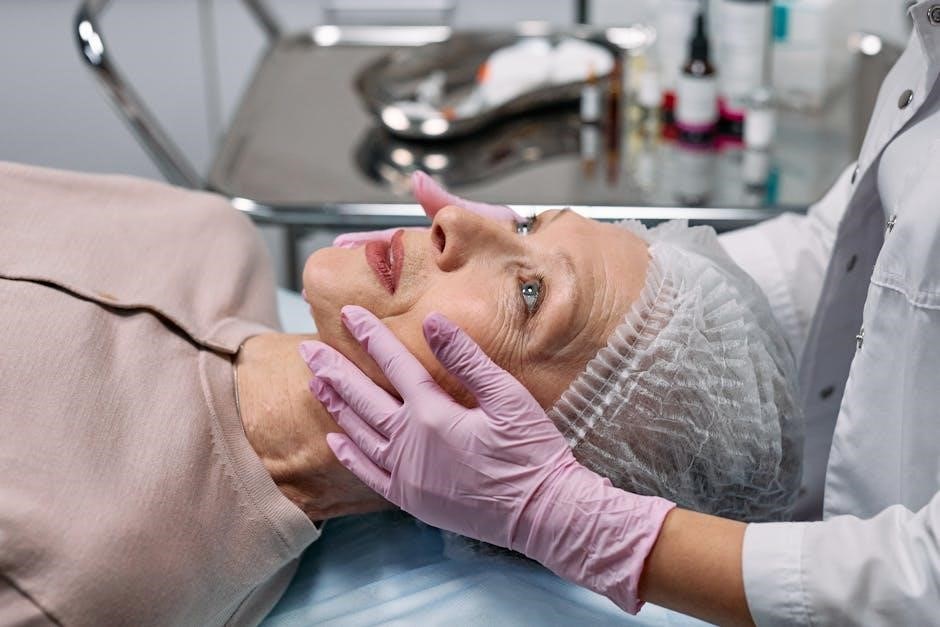A head-to-toe nursing assessment is a systematic approach to evaluating a patient’s physical and functional health status. It is conducted on admission, at the start of each shift, and as needed to identify health concerns and guide care planning. This comprehensive evaluation ensures thoroughness and accuracy in patient care, making it a cornerstone of nursing practice.
Definition and Purpose
A head-to-toe nursing assessment is a systematic, comprehensive evaluation of a patient’s physical and functional health status. It involves inspecting and palpating body systems from the head to the toes to gather data on normal and abnormal findings. The purpose is to identify health concerns, establish baseline data, and inform individualized care plans. This method ensures a thorough and organized approach to patient care, promoting early detection of potential issues and improving outcomes.
Importance in Nursing Practice
A head-to-toe nursing assessment is crucial for providing high-quality, patient-centered care. It enables nurses to systematically gather comprehensive data about a patient’s health status, facilitating early detection of abnormalities and trends. This approach promotes continuity of care, enhances patient safety, and ensures timely interventions. By identifying deviations from normal findings, nurses can prioritize care, address potential complications early, and improve overall patient outcomes, making it a cornerstone of effective nursing practice.
When is a Head-to-Toe Assessment Conducted?
A head-to-toe assessment is conducted upon patient admission, at the start of each shift, and as necessary for individualized care to ensure comprehensive patient evaluation.
On Patient Admission
A head-to-toe assessment is performed upon patient admission to gather baseline data about their physical and functional health. This initial evaluation includes measuring vital signs, assessing each body system, and identifying any pre-existing conditions or acute issues. It helps establish a starting point for care, ensuring that all relevant health information is documented. This comprehensive approach allows nurses to prioritize care needs and develop an individualized plan tailored to the patient’s specific requirements, promoting early detection of potential concerns and enhancing patient safety.
At the Beginning of Each Shift
A head-to-toe assessment is conducted at the start of each shift to evaluate the patient’s current health status and identify any changes since the last evaluation. This systematic review includes vital signs, physical observations, and functional assessments. It ensures continuity of care by updating the care plan and addressing any new concerns. Regular assessments enable early detection of subtle changes, promoting timely interventions and enhancing patient outcomes. This practice is essential for maintaining patient safety and optimizing care delivery.
As Necessary for Patient Care
A head-to-toe assessment may be conducted as needed to address specific patient concerns or changes in condition. This flexible approach ensures timely evaluation of new symptoms, injuries, or deteriorations in health. It allows nurses to monitor progress, adjust care plans, and prevent complications. Unscheduled assessments are crucial for patients with unstable conditions or those requiring close monitoring. This proactive strategy enhances patient safety and supports individualized care tailored to evolving needs;

Step-by-Step Process of a Head-to-Toe Assessment
A head-to-toe assessment is a systematic process starting with a general survey and vital signs, followed by a detailed evaluation of each body system. This ensures thoroughness and accuracy in identifying health concerns and documenting findings for individualized care planning.
General Survey and Vital Signs
The assessment begins with a general survey of the patient’s overall appearance and vital signs, including temperature, pulse, respiration rate, blood pressure, and pain level. These measurements provide baseline data, helping nurses identify deviations from normal and prioritize care. A thorough general survey also includes observing for signs of distress, such as difficulty breathing or changes in skin color, ensuring early detection of potential issues. This step is crucial for comprehensive patient evaluation.
Assessment of Body Systems
Following the general survey, the nurse evaluates each body system systematically, starting with the neurological, cardiovascular, respiratory, gastrointestinal, genitourinary, musculoskeletal, and integumentary systems. This involves inspecting, palpating, percussing, and auscultating to identify abnormalities. For example, listening to heart and lung sounds, assessing skin integrity, and testing range of motion ensures a holistic view of the patient’s health, guiding individualized care plans and interventions to address specific needs effectively.

Documentation and Reporting
Accurate documentation of assessment findings ensures continuity of care. Using checklists or templates, nurses record observations, vital signs, and abnormalities. Timely reporting to healthcare teams promotes effective patient management.
Using a Head-to-Toe Assessment Checklist
A head-to-toe assessment checklist serves as a guide for nurses to systematically evaluate each body system. It includes sections for vital signs, physical observations, and documentation of abnormalities. Checklists ensure thoroughness and consistency, helping nurses identify potential health issues early. They are particularly useful for entry-level nurses to stay organized during assessments. Customizable templates are available online, catering to different patient needs and care settings, ensuring comprehensive and accurate documentation of findings.
Reporting Abnormal Findings
Reporting abnormal findings during a head-to-toe assessment is crucial for ensuring patient safety and effective care. Nurses should document any deviations from normal findings in a clear and concise manner, using standardized checklists to guide the process. Timely communication of these findings to the healthcare team is essential for early intervention and preventing potential complications. Accurate documentation also facilitates continuity of care and legal accountability, ensuring that all abnormalities are addressed promptly and appropriately.

Common Findings and Abnormalities
A head-to-toe assessment reveals normal findings like normal heart rate or abnormal findings such as edema or irregular breathing. Early detection of abnormalities ensures timely interventions.
Examples of Normal and Abnormal Assessment Outcomes
Normal findings include clear lung sounds, regular heart rhythm, and no swelling. Abnormal findings may involve crackles in lungs, irregular heartbeat, or edema. These examples highlight the importance of early detection and documentation in care planning. For instance, a patient with normal vital signs and no pain indicates stable health, while one with abnormal respiratory sounds may require further evaluation. Such outcomes guide nurses in providing targeted interventions and improving patient outcomes.

Special Considerations
Special considerations in head-to-toe assessments involve tailored approaches for specific patient populations, ensuring individualized care and accurate health evaluations.
Pediatric and Geriatric Assessments
Pediatric assessments require attention to developmental milestones and age-specific communication. Geriatric assessments focus on common issues like mobility limitations and chronic conditions. Both populations need tailored approaches, ensuring dignity and comfort. Nurses must use appropriate tools and techniques to address unique needs, such as pain assessment in non-verbal patients or cognitive screenings in the elderly. These assessments guide individualized care plans, promoting optimal health outcomes for vulnerable populations.
Assessment of Critically Ill Patients
Assessing critically ill patients requires frequent, detailed evaluations due to their unstable conditions. Nurses conduct hourly checks of vital signs, neurological status, and organ function. Monitoring for signs of deterioration, such as changes in mental status or hemodynamic instability, is crucial. Tools like EHRs and portable monitors aid in continuous assessment. Early detection of abnormalities enables timely interventions, improving patient outcomes in high-acuity settings. This process demands advanced skills and prompt decision-making to address life-threatening situations effectively.
Tools and Resources
Head-to-toe assessment templates, checklists, and electronic health records (EHRs) are essential tools. These resources help nurses organize findings, ensure thoroughness, and streamline documentation for accurate patient care.
Head-to-Toe Assessment Templates and Guides
Head-to-toe assessment templates and guides provide structured frameworks for conducting thorough patient evaluations. These tools include checklists, body system assessments, and documentation spaces. They ensure consistency and comprehensiveness, covering vital signs, physical examination, and patient history. Nurses can use these guides to systematically review each body system, from the head to the extremities. Templates are especially useful for students and experienced nurses alike, promoting efficiency and accuracy in clinical practice.
Electronic Health Records (EHRs) in Documentation
Electronic Health Records (EHRs) play a pivotal role in documenting head-to-toe assessments, enhancing accuracy and efficiency. EHR systems allow nurses to input detailed findings, track changes over time, and access patient histories effortlessly. Templates within EHRs guide systematic documentation, ensuring no detail is overlooked. Real-time updates and secure sharing facilitate collaboration among healthcare teams, improving patient care coordination. EHRs also support compliance with healthcare standards and provide a permanent, organized record of patient assessments.
Best Practices
Adhere to systematic approaches, ensure accuracy, and follow established protocols. Effective communication and attention to detail are essential for thorough and reliable head-to-toe assessments.
Ensuring Thoroughness and Accuracy
To ensure thoroughness and accuracy in head-to-toe assessments, nurses should use a systematic approach, following established protocols and checklists. Attention to detail is critical, as missing subtle signs can lead to overlooked diagnoses. Documentation should be clear and concise, reflecting all findings accurately. Regular training and practice help maintain proficiency, while collaboration with healthcare teams enhances the reliability of assessment outcomes. Consistency and precision are vital for delivering high-quality patient care.
Communication and Collaboration with Healthcare Teams
Effective communication and collaboration with healthcare teams are essential for accurate head-to-toe assessments. Nurses must clearly report findings, ensuring timely sharing of critical information. Active participation in interdisciplinary meetings helps prioritize care and address patient needs collectively. Using standardized tools, like checklists, enhances consistency and clarity in communication. This teamwork fosters a collaborative environment, improving patient outcomes and ensuring comprehensive care planning. Open dialogue and shared responsibilities are vital for delivering safe and effective patient care.
A head-to-toe nursing assessment is a vital tool for ensuring comprehensive patient care; It promotes early detection of health issues, enabling timely interventions and improving patient outcomes significantly.
A head-to-toe nursing assessment is a systematic evaluation of a patient’s health status, conducted on admission, at shift starts, and as needed. It ensures thoroughness, accuracy, and early detection of abnormalities. Using checklists and tools, nurses gather vital data, document findings, and communicate results to the healthcare team. This process is essential for developing individualized care plans, promoting patient safety, and enhancing overall outcomes in clinical settings.
Continuing Education for Nurses
Continuing education is crucial for nurses to refine their head-to-toe assessment skills and stay updated on best practices. Nurses can access resources like step-by-step guides, checklists, and templates to enhance their proficiency; Workshops, online courses, and peer collaboration also provide opportunities for professional growth. Regular training ensures accuracy and thoroughness in assessments, ultimately improving patient care and safety.
